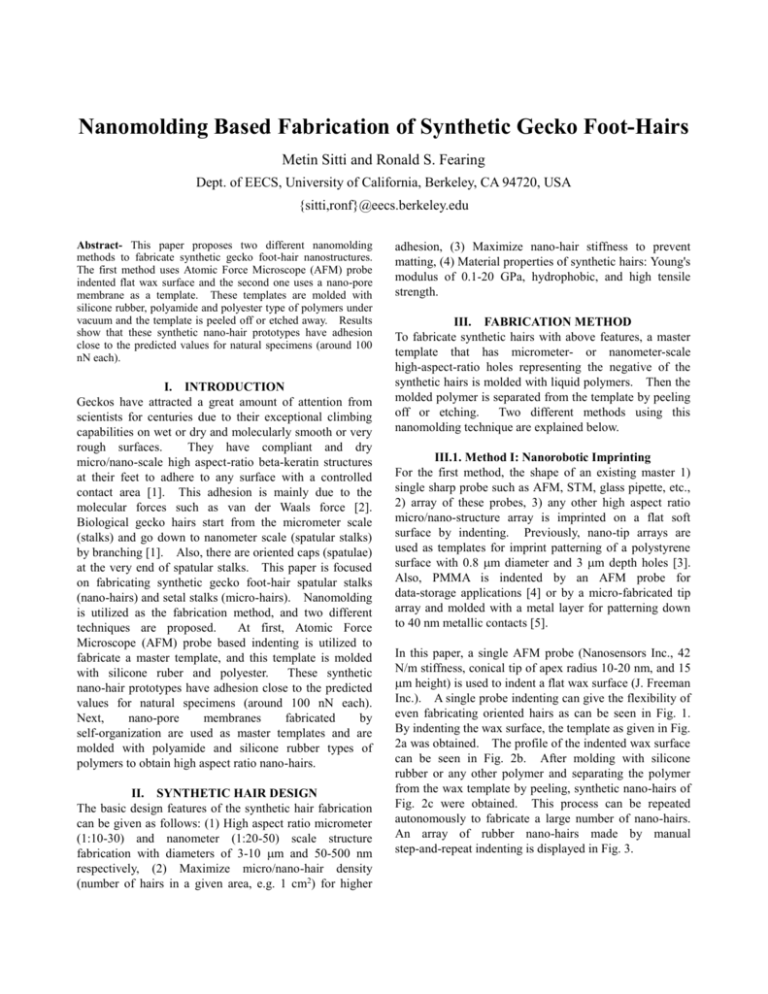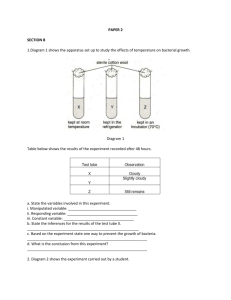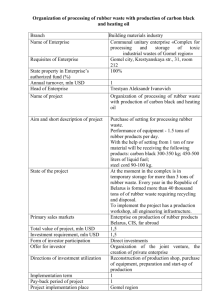nano02_paper114
advertisement

Nanomolding Based Fabrication of Synthetic Gecko Foot-Hairs
Metin Sitti and Ronald S. Fearing
Dept. of EECS, University of California, Berkeley, CA 94720, USA
{sitti,ronf}@eecs.berkeley.edu
Abstract- This paper proposes two different nanomolding
methods to fabricate synthetic gecko foot-hair nanostructures.
The first method uses Atomic Force Microscope (AFM) probe
indented flat wax surface and the second one uses a nano-pore
membrane as a template. These templates are molded with
silicone rubber, polyamide and polyester type of polymers under
vacuum and the template is peeled off or etched away. Results
show that these synthetic nano-hair prototypes have adhesion
close to the predicted values for natural specimens (around 100
nN each).
I. INTRODUCTION
Geckos have attracted a great amount of attention from
scientists for centuries due to their exceptional climbing
capabilities on wet or dry and molecularly smooth or very
rough surfaces.
They have compliant and dry
micro/nano-scale high aspect-ratio beta-keratin structures
at their feet to adhere to any surface with a controlled
contact area [1]. This adhesion is mainly due to the
molecular forces such as van der Waals force [2].
Biological gecko hairs start from the micrometer scale
(stalks) and go down to nanometer scale (spatular stalks)
by branching [1]. Also, there are oriented caps (spatulae)
at the very end of spatular stalks. This paper is focused
on fabricating synthetic gecko foot-hair spatular stalks
(nano-hairs) and setal stalks (micro-hairs). Nanomolding
is utilized as the fabrication method, and two different
techniques are proposed.
At first, Atomic Force
Microscope (AFM) probe based indenting is utilized to
fabricate a master template, and this template is molded
with silicone ruber and polyester.
These synthetic
nano-hair prototypes have adhesion close to the predicted
values for natural specimens (around 100 nN each).
Next,
nano-pore
membranes
fabricated
by
self-organization are used as master templates and are
molded with polyamide and silicone rubber types of
polymers to obtain high aspect ratio nano-hairs.
II. SYNTHETIC HAIR DESIGN
The basic design features of the synthetic hair fabrication
can be given as follows: (1) High aspect ratio micrometer
(1:10-30) and nanometer (1:20-50) scale structure
fabrication with diameters of 3-10 m and 50-500 nm
respectively, (2) Maximize micro/nano-hair density
(number of hairs in a given area, e.g. 1 cm2) for higher
adhesion, (3) Maximize nano-hair stiffness to prevent
matting, (4) Material properties of synthetic hairs: Young's
modulus of 0.1-20 GPa, hydrophobic, and high tensile
strength.
III. FABRICATION METHOD
To fabricate synthetic hairs with above features, a master
template that has micrometer- or nanometer-scale
high-aspect-ratio holes representing the negative of the
synthetic hairs is molded with liquid polymers. Then the
molded polymer is separated from the template by peeling
off or etching.
Two different methods using this
nanomolding technique are explained below.
III.1. Method I: Nanorobotic Imprinting
For the first method, the shape of an existing master 1)
single sharp probe such as AFM, STM, glass pipette, etc.,
2) array of these probes, 3) any other high aspect ratio
micro/nano-structure array is imprinted on a flat soft
surface by indenting. Previously, nano-tip arrays are
used as templates for imprint patterning of a polystyrene
surface with 0.8 m diameter and 3 m depth holes [3].
Also, PMMA is indented by an AFM probe for
data-storage applications [4] or by a micro-fabricated tip
array and molded with a metal layer for patterning down
to 40 nm metallic contacts [5].
In this paper, a single AFM probe (Nanosensors Inc., 42
N/m stiffness, conical tip of apex radius 10-20 nm, and 15
m height) is used to indent a flat wax surface (J. Freeman
Inc.). A single probe indenting can give the flexibility of
even fabricating oriented hairs as can be seen in Fig. 1.
By indenting the wax surface, the template as given in Fig.
2a was obtained. The profile of the indented wax surface
can be seen in Fig. 2b. After molding with silicone
rubber or any other polymer and separating the polymer
from the wax template by peeling, synthetic nano-hairs of
Fig. 2c were obtained. This process can be repeated
autonomously to fabricate a large number of nano-hairs.
An array of rubber nano-hairs made by manual
step-and-repeat indenting is displayed in Fig. 3.
stickiness of rubber might be contributing the measured
adhesion force, rather than a more universal van der Waals
attraction. Thus, polyester was also tried as the molding
polymer material.
Polyester Young's modulus is
measured as around 0.85 GPa. Thus, it is a better match
to the natural nano-hair modulus. A molded polyester
bump is shown in Fig. 4.
Fig. 1. Synthetic hair fabrication by the Method I: (a) Indenting
a flat wax surface using a micro/nano-fabricated probe, (b)
molding it with a polymer, (c) separating the polymer from the
wax by peeling.
Fig. 3. 3D AFM tapping mode image of a silicone rubber
nano-hair array fabricated by repeated AFM probe indenting.
(a)
(b)
(c)
Fig. 2. 3D AFM tapping mode image of (a) the AFM probe
based indented flat wax surface, (b) profile of the indented wax
surface, (c) molded and peeled off silicone rubber nano-hairs.
Synthetic nano-hairs were fabricated from two different
hydrophobic polymer materials (around 87 o contact angle
with DI water), silicone rubber (Dow Corning Inc., HS II)
and polyester resin (TAP Plastics Inc.). Silicone rubber
Young's modulus was measured as 0.57 MPa. It was
determined by measuring the stiffness of a molded
known-size rectangular rubber beam. However, feather
beta-keratin is measured as 1-10 GPa [6], and gecko
foot-hairs is estimated in the range of 1-15 GPa from our
measurements using an AFM probe based bending of a
single Tokay gecko stalk. While rubber has good
adhesive properties, we had some concern that the natural
Fig. 4. A polyester synthetic nano-hair fabricated by molding
an AFM probe indented wax surface.
To characterize the adhesion of synthetic hairs to a silicon
surface with a natural oxide layer, pull-off force
measurements were conducted using unloading
force-distance plots as in Fig. 5 with a tipless rectangular
silicon AFM probe with 1.75 N/m stiffness and 390 nm/s
retraction speed. In the unloading force-distance curves,
the maximum attractive (pull-off) force gives the adhesion
of the synthetic nano-hair to the probe SiO2 surface.
Measurements were made in a laboratory environment
with 25oC and 58% relative humidity. Pull-off force was
measured as 181 ± 9 nN (25 samples) for silicone rubber
nano-hair with tip radius range of 230-440 nm (measured
from the 3D AFM image) and 294 ± 21 nN (20 samples)
for polyester nano-hair with tip radius of 350 nm. We
thus have shown good repeatability. The RMS surface
roughness of silicone rubber and polyester flat substrates
are measured by AFM as around 3 nm and 5 nm
respectively. Since these values are relatively small and
we could not measure the roughness at the tip of the
synthetic nano-hairs directly, the roughness effect on
surface forces was neglected.
Pull-off force is given by the JKR theory as F=1.5RW,
where W 2 1 2 [7]. 1=160 ± 40 mJ/m2 [8] and
2 are the surface energies of the SiO2 layer and the
polymer respectively. For silicone rubber with 2=21.4
mJ/m2 [9], 185 nN pull-off force is theoretically expected
taking R335 nm. For polyester with 2=44.6 mJ/m2 [9],
279 nN is expected. These expected adhesion forces are
very close to the measured ones.
This adhesive force is consistent with van der Waals force.
For calculating the van der Waals contribution of these
adhesion forces, Fvdw=HR/6d02 is used where d00.165 nm
is the approximate interfacial cut-off distance [7] and H is
the Hamaker constant. Using H45 x 10-21 J (estimated
from H=2.1 x 10-24 [7]) for rubber, H=60.5 x 10-21 J [10]
for polyester, and H=68.5 x 10-21 J [10] for SiO2, Fvdw=114
nN and Fvdw=139 nN are predicted for silicone rubber and
polyester respectively.
Thus, 47-63% of the adhesion
forces of the synthetic nano-hairs are consistent with the
van der Waals forces while the rest could be due to polar
interactions, other adhesive effects and surface roughness
effects.
Fig. 5. Pull-off force measurements of the synthetic (silicone
rubber (dashed line) and polyester (solid line)) nano-hairs using a
tipless AFM probe.
III.2. Method II: Parallel Fabrication
For the second method, a membrane with self-organized
high aspect ratio pores is used as the master template and
molded with a liquid polymer. Two types of membranes
were used: alumina (Nanopore, Whatman Inc.) and
polycarbonate (Poretics, Osmonics' Lab Inc) membranes.
They have different range of diameter, density and
thickness of pores, Young's modulus, etching properties,
etc. (Table 1).
Material
Pore Diameter
(m)
Thickness
(m)
Pore Density
(pores/cm2)
Alumina
Polycarbonate
0.02-0.2
0.02-20
60
7-14
109
105-108
Table 1. Properties of nano-pore membranes.
First, an alumina membrane with 200 nm diameter and 60
m thick perpendicular nano-pores was molded with
polyamide (PI-2525, HD Microsystems Inc) and silicone
rubber (HSII) under vacuum. After molding, polyamide
was cured at 100oC for 1 hr, 200oC for 30 min, and 350oC
for 1 hr, and the alumina membrane is etched away by
HCl in 2 hr. Scanning Electron Microscope (SEM)
micrographs of the alumina membrane top-view and
polyamide nano-hairs are given in Fig. 6a and 6b
respectively. Here, membrane and the polyamide hairs
are coated with a 10 nm thick gold layer for SEM imaging.
Since wet etching is utilized and nano-hairs are extremely
compliant (long), hydrophobic polyamide hairs stuck to
each other. Moreover, silicone rubber was also molded
using the same membrane and the resulting nano-hairs are
shown in Fig. 6c. As can be seen from the results, 60 m
long nano-hairs are too compliant and too dense (i.e. too
close to each other) to prevent self-sticking while molding
of down to 200 nm nano-pores with liquid polymers under
vacuum is demonstrated successfully.
Therefore,
synthetic hairs should be much shorter and less dense,
and/or external excitation such as ultrasonic vibration or
proper surfactants for the given etchant should be used
during the wet etching process to minimize the
self-sticking problem due to hydrophobic attraction.
For shortening the nano-hairs and decreasing the nano-hair
density, polycarbonate membranes were used. These
membranes have a random orientation of the nanopores
(±15o) created by a nuclear track etch. The SEM
micrograph of a polycarbonate membrane is displayed in
Fig. 7a. A 8 m diameter polycarbonate membrane was
molded with silicone rubber under vacuum and the rubber
is peeled off from the membrane after curing at room
temperature for 24 hr. Resulting rubber hairs with
around 6 m diameter and length are shown in Fig. 7b.
Smaller diameter (down to 200 nm) membrane molding is
currently in progress. Adhesion of rubber hair array in
Fig. 7b to a flat glass substrate is measured using a force
sensor as around 2.8 mN/cm2 for a 25 mN preload. This
implies around 60 nN adhesion for each single hair using
the fabricated hair density of 5 x 104 pores/cm2 and
assuming all hairs contact to the substrate.
IV. CONCLUSION
Synthetic gecko foot-hair nano-hairs were fabricated by
two different nanomolding techniques.
AFM
probe-based indented flat wax surface in the Method I and
self-organized alumina and polycarbonate nano-pore
membranes in the Method II were used as the master
templates. The Method I resulted in nano-hairs with
adhesion forces in the range of 180-300 nN while the
biological nano-hairs give around 50-300 nN [1]. Thus,
the generated sticking forces are similar, and we have
shown that the adhesive forces are 1) relatively
independent of material properties, 2) repeatable, 3)
consistent with a standard adhesive model. The Method
II preliminary results are promising for mass production,
but further optimization is required to obtain stalks with
appropriate length and diameter.
REFERENCES
[1] K. Autumn, and et. al, ``Adhesive force of a single gecko
foot-hair,'' Nature, vol. 405, pp. 681-685, June 8 2000.
[2] K. Autumn, M. Sitti, Y. Liang, and et. al, ``Evidence for van
der Waals attachment by gecko foot-hairs inspires design of
synthetic adhesive,'' Proc. of the National Academy of Science,
2002 (under review).
[3] T. Dam and P. Pantano, ``Nanotip array photoimprint
lithography,'' Review of Scientific Instruments, vol. 70, no. 10,
pp. 3982-6, Oct. 1999.
[4] U. Durig and et al., ``Millipede-an AFM data storage system
at the frontier of nanotribology,'' Tribology Letters, vol. 9, pp.
25-32, 2000.
[5] T. Borzenko and et al., ``Imprint with sharp tip stamps,''
Microelectronic Engineering}, vol. 57-58, pp. 389-396, 2001.
[6] J. Vincent, Structural Biomaterials, rev. ed., Princeton Univ.
Press, 1990.
[7] J. Israelachvili, Intermolecular and Surface Forces, 2nd Ed.,
Academic Press, London, 1992.
[8] M. Yu, T. Kowalewski, and R. Ruoff, ``Structural analysis of
collapsed and twisted multi-walled carbon nanotubes by Atomic
Force Microscopy,'' Phys. Rev. Lett., vol. 86, 2000.
[9] R. French, ``Origins and applications of London dispersion
forces and Hamaker constants in ceramics,'' J. Am. Ceram. Soc.,
vol. 83, pp. 2127-46, 2000.
[10] L. Li, V. Mangipudi, M. Tirrell, and A. Pocius, ``Direct
measurement of surface and interfacial energies of glassy
polymers and PDMS,'' Fundamentals of Tribology and Bridging
the Gap between the Macro-and Micro/Nanoscales, Kluwer
Academic Pub., Netherlands, 2001.
Fig. 6. SEM micrographs of (a) porous alumina membrane
top-view (uppermost), (b) molded polyamide nano-hairs
(middle), (c) molded silicone rubber nano-hairs (lowermost).
ACKNOWLEDGEMENTS
This work was supported by DARPA N66001-00-C-8047 and
N66001-01-C-8072 from the Controlled Biological and
Biomimetic Systems Program, Defense Sciences Office, under
the auspices of Dr. Alan Rudolph. Authors would thank Prof.
Kellar Autumn (Lewis and Clark College) for measuring
adhesion of the rubber hair array, and Murat Ozturk for assisting
in membrane molding experiments.
Fig. 7. SEM micrographs of (a) polycarbonate membrane
top-view image (upper), and (b) molded silicone rubber hairs
with around 6 m diameter, 6 m length and 5 x 104 pores/cm2
density (lower).







